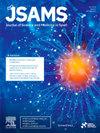超声评估大腿脂肪厚度是有效的估计体脂率在大学一级女运动员。
IF 3
2区 医学
Q1 SPORT SCIENCES
引用次数: 0
摘要
目的:监测身体成分有助于优化女运动员的表现。本研究旨在建立双能x线吸收仪测量的体脂百分比与超声测量的一级女运动员皮下脂肪厚度之间的转换方程,作为一种更容易获得、成本效益更高的替代方法。设计:横断面研究。方法:我们招募了82名甲级女运动员。采用双能x线吸收仪评估体脂率。在股骨长度的50% %处进行双侧全景大腿超声扫描,计算股直肌上覆的皮下脂肪厚度。将数据集分为训练样本(70 %,n = 57)和保留样本(30 %,n = 25),分别开发和验证转换方程。利用训练样本,通过超声脂肪厚度、质量和身高,采用逐步线性回归预测双能x线吸收仪体脂率。这个模型的贝塔系数被用来建立一个转换方程。将转换方程应用于钉子手样本后,使用类内相关系数(ICC2,k)和Bland-Altman图来确定超声估计的体脂百分比与dxa导出的体脂百分比之间的一致性。结果:在训练样本中,双能x线吸收仪与超声脂肪厚度、身高和质量显著相关(F = 31.9; 2 = 0.64页)。在顽固样本中,当使用转换方程来估计体脂百分比时,我们发现估计的体脂百分比与dxa推导的体脂百分比之间存在很强的一致性(ICC2,k = 0.93;95 % ci: 0.83-0.97)。结论:超声评估的皮下大腿脂肪厚度预测双能x线吸收仪评估的一级女运动员体脂率。本文章由计算机程序翻译,如有差异,请以英文原文为准。
Ultrasound-assessed thigh fat thickness is valid for estimating body fat percentage in Division I collegiate female athletes
Objectives
Monitoring body composition can help to optimize performance in female athletes. This study aimed to create a conversion equation between dual-energy X-ray absorptiometry-measured body fat percentage and ultrasound-measured subcutaneous thigh fat thickness in Division I female athletes as a more accessible, cost-effective alternative.
Design
Cross-sectional study.
Methods
We enrolled 82 Division I female athletes. Dual-energy X-ray absorptiometry was used to assess body fat percentage. Bilateral panoramic thigh ultrasound scans at 50 % of the femur length were used to calculate subcutaneous fat thickness overlying the rectus femoris muscle. The dataset was divided into a training (70 %, n = 57) and holdout (30 %, n = 25) sample to develop and validate the conversion equation, respectively. Using the training sample, a stepwise, linear regression was used to predict dual-energy X-ray absorptiometry body fat percentage from ultrasound fat thickness, mass, and height. Beta coefficients from this model were used to create a conversion equation. After applying the conversion equation to the holdout sample, intraclass correlation coefficients (ICC2,k) and Bland–Altman plots were used to establish the agreement between the ultrasound-estimated and DXA-derived percent body fat.
Results
Within the training sample, dual-energy X-ray absorptiometry was significantly associated with ultrasound fat thickness, height, and mass (F = 31.9; p < 0.001; R2 = 0.64). Within the holdout sample, when using the conversion equation to estimate body fat percentage, we found a strong agreement between estimated and DXA-derived percent body fat (ICC2,k = 0.93; 95 % CI: 0.83–0.97).
Conclusions
Ultrasound-assessed subcutaneous thigh fat thickness predicts dual-energy X-ray absorptiometry-assessed body fat percentage in Division I female athletes.
求助全文
通过发布文献求助,成功后即可免费获取论文全文。
去求助
来源期刊
CiteScore
7.40
自引率
10.00%
发文量
198
审稿时长
48 days
期刊介绍:
The Journal of Science and Medicine in Sport is the official journal of Sports Medicine Australia (SMA) and is an an international refereed research publication covering all aspects of sport science and medicine.
The Journal considers for publication Original research and Review papers in the sub-disciplines relating generally to the broad sports medicine and sports science fields: sports medicine, sports injury (including injury epidemiology and injury prevention), physiotherapy, podiatry, physical activity and health, sports science, biomechanics, exercise physiology, motor control and learning, sport and exercise psychology, sports nutrition, public health (as relevant to sport and exercise), and rehabilitation and injury management. Manuscripts with an interdisciplinary perspective with specific applications to sport and exercise and its interaction with health will also be considered.

 求助内容:
求助内容: 应助结果提醒方式:
应助结果提醒方式:


